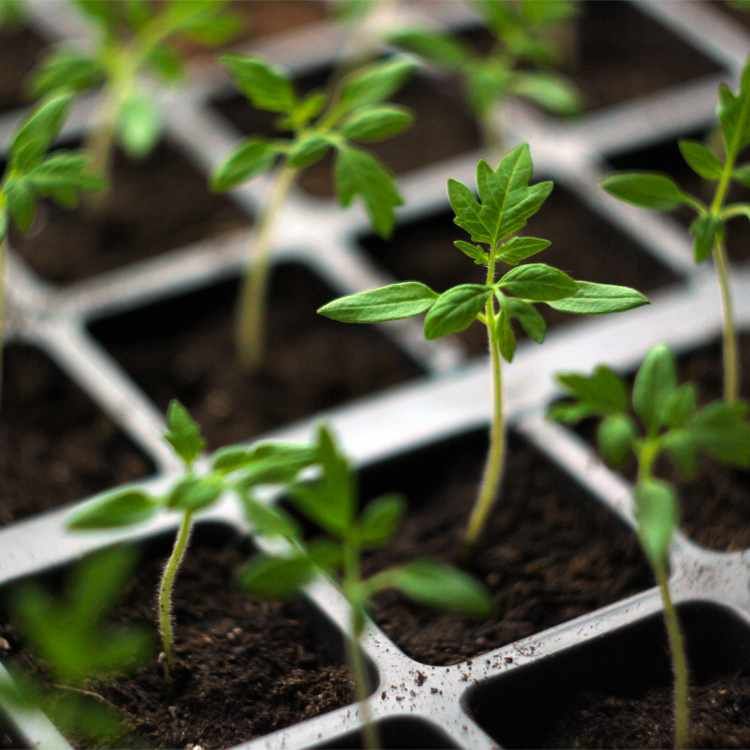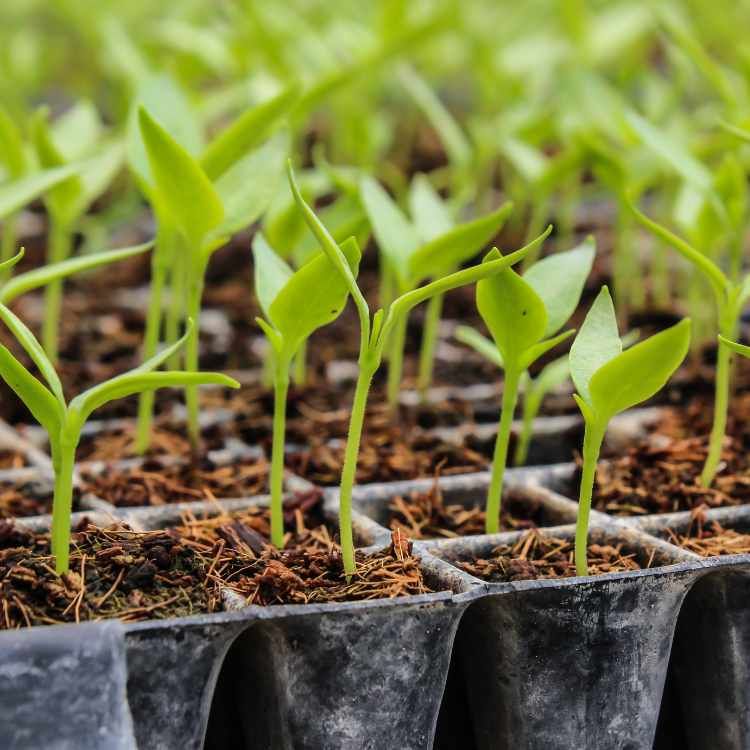
Key Takeaways
Damping off is a fungal disease that can destroy seedlings, but it’s preventable.
Creating a sterile environment and using the right soil mix are crucial first steps.
Water seedlings wisely to avoid overwatering, which can lead to damping off.
Proper temperature and light are vital for healthy seedling growth and disease prevention.
If damping off occurs, isolate affected seedlings and use natural or chemical treatments.
Damping Off: What Is It?
Damping off might sound like a gentle letdown, but for seedlings, it’s anything but. It’s a silent assassin, a disease caused by several different fungi that attack young plants just as they begin their journey. The result? A gardener’s nightmare: wilted, collapsed, and dead seedlings. But fear not, with a bit of know-how, you can prevent this garden foe from ever taking hold.
Recognizing the Warning Signs
Before we dive into the nitty-gritty of prevention, let’s make sure you can spot the enemy. Damping off typically strikes seedlings at the soil line, causing them to become soft, discolored, and eventually topple over as if they’ve been cut down. You might also see a fuzzy growth if the conditions are especially wet. It’s a heartbreaking sight, but being able to identify these signs early can save the rest of your crop.
Setting the Stage for Success
Now, let’s talk about setting up your seedlings for a strong start. The right beginning can make all the difference between a thriving garden and a fungal wasteland.
Crafting a Sterile Environment for Seedlings
The first line of defense is cleanliness. Your seed trays, tools, and pots should be as clean as a whistle. You can use a solution of one part bleach to nine parts water to sanitize everything that will come into contact with your seedlings. It’s like creating a bubble of protection that those pesky fungi can’t penetrate. For more guidance on creating a sterile environment for your survival garden, consider exploring additional resources.
Choosing the Right Soil Mix
The soil you choose is more than just dirt; it’s the foundation of your seedling’s life. For the best defense against damping off, opt for a sterile potting mix that’s specifically designed for seed starting. These mixes are free from the pathogens lurking in garden soil and provide the perfect balance of drainage and moisture retention.
Remember, damping off thrives in wet conditions, so a well-draining mix will help keep the water levels in check. If you’re mixing your own, a combination of peat, vermiculite, and perlite is a good bet. This trio works together to keep your seedlings snug and dry where it counts.
Watering Wisely

Water is life, but it can also bring death in the form of damping off. The key is to provide just enough moisture without going overboard.
The Perils of Overwatering
Overwatering is like throwing a pool party for fungi: they love it, and they’ll invite all their friends. To prevent this, water your seedlings when the top of the soil feels dry to the touch. It’s a simple trick that keeps the soil from becoming a fungal playground.
Stay tuned for the next part where we’ll delve deeper into the watering techniques that can keep damping off at bay and ensure your seedlings grow up strong and healthy.
But what about the method of watering? That’s where bottom watering comes into play, and it’s a game-changer.
Bottom Watering Benefits
Bottom watering means you provide water to the plants from below, allowing the roots to soak up moisture as needed. This method encourages deeper root growth and helps keep the foliage dry, which is critical because damp leaves can spell disaster and invite damping off. Just place your seed trays in a shallow container of water and let the soil wick up the moisture. It’s a more consistent and gentle way to hydrate your seedlings.
Ensuring Ideal Growing Conditions

Aside from watering, the conditions in which your seedlings grow play a massive role in preventing damping off. Let’s make sure your little green friends have everything they need to fend off fungal foes.
Temperature Control Tactics
Seedlings like it warm, but not too warm. A consistent temperature between 65-75°F (18-24°C) is just right. If you can keep the soil temperature in this Goldilocks zone, you’ll speed up germination and reduce the risk of damping off. Seedling heat mats are perfect for this, especially during those cooler months.
For example, if you’re starting tomatoes, they’ll need that extra warmth to germinate quickly and outpace any potential fungi. A heat mat can raise the soil temperature by 10-20°F above room temperature, which can make all the difference.
Now, let’s shed some light on the subject—literally.
Optimizing Light Exposure
Light is another critical factor. Seedlings need plenty of it; without enough light, they become leggy and weak, which makes them more susceptible to damping off. Provide 14-16 hours of bright, indirect light each day. Grow lights are an excellent investment for this, especially if you’re starting seeds indoors where natural light might be limited.
But too much direct sunlight can scorch your delicate seedlings, so if you’re using a sunny windowsill, watch out for those intense midday rays. A sheer curtain can help diffuse the light and protect your plants.
When Prevention Fails: Treatment Strategies
Despite your best efforts, sometimes damping off can still strike. It’s important to act fast to save the rest of your seedlings.
Isolating Affected Seedlings
The first step is to remove any affected plants immediately. This isn’t the time for sentimentality; think of it as a quarantine to protect the healthy individuals. Get those sickly seedlings out of there, and make sure to dispose of them far from your garden to prevent the spread of spores.
Natural and Chemical Controls
If you’re dealing with a damping off outbreak, you have a couple of options. For a natural approach, cinnamon is a surprising ally—it’s a natural fungicide. Sprinkle it on the soil surface to help prevent the growth of damping off fungi.
For those who prefer a more direct attack, chemical fungicides can be effective, but they should be used as a last resort and always according to the label’s instructions. Remember, the goal is to grow healthy plants, not to create a chemical soup.
In the next part, we’ll continue with more in-depth strategies for damping off prevention and treatment, ensuring that your survival garden thrives.
When it comes to natural controls, it’s not just cinnamon that can come to the rescue. Chamomile tea is another household item that doubles as a mild fungicide. A weak chamomile tea solution used to water your plants can help fend off fungal threats. It’s all about creating an environment that’s not welcoming to the pathogens that cause damping off.
For chemical controls, products containing thiram or captan are often recommended. However, always use these with caution and respect for the environment. Overuse can lead to resistance and harm beneficial organisms in the soil. It’s a balancing act between protecting your seedlings and maintaining a healthy ecosystem.
FAQs
In our journey to empower gardeners globally, we’ve encountered numerous questions. Here are some of the most common queries with straightforward answers to help you in your fight against damping off.
What Exactly Causes Damping Off?
Damping off is caused by a variety of fungi, including Pythium, Fusarium, and Rhizoctonia. These fungi are common in soils and can quickly overwhelm seedlings with their spores. The disease spreads rapidly in conditions that favor fungal growth—excessive moisture, poor air circulation, and cool temperatures.
Can Damping Off Affect Plants Beyond the Seedling Stage?
Typically, damping off targets seedlings due to their tender, undeveloped stems and roots. However, if conditions are right for the fungi and the plant’s growth is stunted, older plants can still be at risk, although it’s much less common.
How Often Should I Water My Seedlings?
Water your seedlings when the top layer of soil feels dry to the touch. This might be every couple of days, but it’s crucial to check the soil moisture level rather than sticking to a rigid schedule. Overwatering can create the damp conditions that lead to damping off.
What Temperatures Are Ideal for Seedling Growth?
The ideal temperature range for most seedlings is between 65-75°F (18-24°C). Consistency is key, as fluctuations can stress the plants, making them more susceptible to diseases like damping off.
Are There Resistant Plant Varieties to Consider?
While no plant is entirely resistant to damping off, some are less susceptible than others. Choosing robust varieties and providing optimal growing conditions will always be your best defense. Research the specific needs of each plant type you’re growing to ensure you’re giving them the best chance at a healthy start.
In conclusion, damping off can be a challenging adversary, but with the right knowledge and tools, you can safeguard your seedlings and enjoy a thriving garden. Remember to start with a sterile environment, choose the right soil, water wisely, and maintain ideal growing conditions. If you do encounter damping off, act quickly with either natural or chemical controls.
Most importantly, gardening is a journey of learning and growth—both for you and your plants. Embrace the process, and don’t let setbacks dampen your spirits. With each seed you sow, you’re contributing to a greener, healthier world.
For those looking to equip their gardens with the best defense against damping off, consider visiting Survival Essentials for a selection of gardening products that can help you create a thriving, disease-resistant garden. Whether you’re a novice or an experienced gardener, their curated collection is designed to enhance your gardening success and ensure your seedlings have the best start in life.
Happy gardening, and may your seedlings grow strong and free from the clutches of damping off!







Leave a Reply